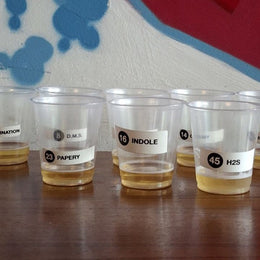
Cristalino may seem like a blanco tequila first but actually cristalino tequila is basically an overfiltered aged tequila.
Some labels use the term “clear” instead of cristalino, but it refers to the same thing.
These tequilas typically belong to one of the aged classifications like reposado, añejo or extra añejo.


There are two major ways producers can produce such white aged tequilas.
The most popular seems to be the filtration. Basically when producers apply a filtration technique, they remove certain molecule sizes. Even normal aged tequilas are usually filtered, but their filtration is a lot more careful. It is important to understand that in case of a cristalino tequila not only the color giving barrel particles but the aroma carrying molecules are filtered as well.
The other way to create a cristalino is by distilling tequila one more time. As the color giving molecules are solid particles, they cannot fly through the still and so the tequila that comes off the still is white just like a blanco tequila.

Cristalino tequila was never designed for serious tequila consumers.
The problem is that this process takes away the flavors which can add a certain depth or richness to aged tequilas.
On the other hand classifications such as reposado, añejo and extra añejo do allow for a higher level of additives and this is something producers may take advantage of.

Flavored tequilas in a way are opposite to cristalinos - instead of removing aroma molecules producers add them in. Here we can talk about two different kinds of products.
One is still a tequila and producers can add up to 85g/L dry aroma extract and 75g/L sugars. Putting on the name of the aroma is compulsory though and it has to be an aroma approved by the Health Secretary.
And then there are drinks containing tequila. There is a soft unofficial minimum 25% tequila content requirement for such drinks to be able to display tequila as an ingredient. Such labels are also subject to approval by the CRT (Tequila Regulatory Council), to make sure the context in which the word tequila is presented is correct.

The way to distinguish between these two variations is how the term tequila is used.
If the drink is called tequila and a flavor is just simply added, then it actually counts as tequila.
If tequila is clearly displayed as an ingredient such as - 100% agave tequila was used for this product - then it is not a tequila and brands are even required to put the term liqueur on the label to further reinforce this. There is absolutely no restrictions on the flavors that producers can use, from coffee, chocolate, coconut, mango, there is a great variation you can find when shopping for tequilas.

Let’s talk about how the regulation changed, giving more options and flexibility for producers to make wide range of different tequilas like the relatively new cristalino or flavoured ones.
The original European way of denominations is about preserving tradition by protecting and promoting it and producers have to comply with high standards of quality to make sure consumers are getting a top notch product.
This allows producers to charge a higher fee to compensate for their higher production costs. Tequila started out like that. Tequila had to be made in a very certain way that ensured that it has a very unique and high quality.
As tequila became more and more popular and the demand surged, the industry could not adapt with the supply as it takes a long time to grow new agaves.
So to support the growth of the industry, the high quality restrictions were slowly removed and there are only a handful of tequilas that are made in a similar way as was required in the 1950s.

First changes: Allowing dilution aka Mixto tequila was born
Producers were allowed to dilute their tequilas by adding non-agave sugars to ferment with the agave sugars. This allowance was only 30% first but was later elevated to 49%. Dilution with cheaper ingredients is not unique - even Scotch whisky or Bourbon allow for this. Malt whiskies are superior to grain whiskies and it is reflected in the prices. Cheaper options allow the industry to grow so everyone wins. Except for the denomination, which is no longer a clear setting for traditions and quality excellence.

Further changes: Allowing flavours
The tequila industry seems to be the standard setter in going one step further. Many spirits are mixed into cocktails anyways, so why not allow the production of tequila which is flavored like in the case of flavored vodkas or spiced rums? Well there we have it with all its controversy it generated amongst traditional producers. Will Scotch, Cognac and the others follow? Only time can tell.
Still one thing is for sure. Newbies love flavored tequilas and cristalinos while aficionados despise them. In the end it all comes down to knowing what you drink.
This feature is brought to you by Tequila Stop and the International Tequila Academy.
Tequila Stop aims to share is love for Mexico and its beloved Spirit with fans in Asia Pacific, bringing fans the best that Tequila has to offer, through an extensive catalogue of premium Tequilas and Mezcals straight from the source. Tequila Stop works closely with Mezcaleros across Mexico, and is also partners with the International Tequila Academy.








